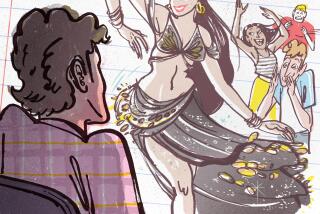Getting Wiggly With It
- Share via
The bellies were bulging and wrinkled, fat and firm. Rippled, dimpled, pierced, protruding, sloped, rolled and toned. But however they looked, all were shimmying.
Mesmera, a belly dancer from Silver Lake in a beaded, red body suit and veil, brought the house down with her wriggles and jiggles. Kristen Cunningham, a raven-haired 37-year-old with twin tongue studs and a Celtic tattoo, entertained with hip snaps and hand ripples. Patty Campbell, a 71-year-old who was wearing a midriff-baring top and maroon harem pants, practiced graceful Sufi turns and chest circles. And Danielle Wilson, a 16-year-old with hip-length blue and purple braids, synchronized snake arms with her aunt.
More than 3,200 people--most of them women--attended last weekend’s 15th Annual Cairo Carnivale at the Glendale Civic Auditorium, a two-day extravaganza hosted by the Middle Eastern Culture and Dance Assn., or MECDA. They came to shake their stuff on stage, watch other dancers and shop in a bazaar that offered everything from hand-beaded bra- and belt sets to scimitars and videos with titles such as “Hips!” and “Lock, Roll and Flutter.”
Belly dancing is not something they do to please men, the women said, and indeed, few men attended. The dancers came to celebrate their femininity--regardless of body shape, size or age.
During the two-day Carnivale, 500 entertainers performed 130 separate shows on two different stages. In dance and dress, they encompassed everything from “I Dream of Jeannie” Egyptian and Turkish styles to the increasingly popular American tribal genre, with women performing in groups wearing face paint, long velvet skirts and chunky silver jewelry.
Dancers ranged from abject amateurs who’d only recently mastered basic moves to seasoned pros. Somewhere in between were Cunningham and the members of her 12-woman troupe Jewels of the Dance. Wearing black harem pants and sequined halters, they rocked the casbah with a routine that blended traditional Mideastern moves with rock and disco.
“Belly dancing is so sensual and empowering and beautiful and exotic,” said Cunningham, who has 10 piercings in each ear to go with her tongue studs. An accountant by day, she teaches a beginning belly dance class at Glendale Community College. “I love the way it embraces all women, all body shapes, all ages.”
Campbell started belly dancing in her 40s. Twenty-eight years later, she is still shimmying--alongside women who work as lawyers, doctors, even a roller-hockey player--as part of a troupe called Moondancers. One of about 30 women who attended Saturday morning’s belly dance workshop, she did hip-rolling figure-eights next to women who were half, even a quarter, of her age.
“There’s so much acceptance in the belly dance movement of women’s bodies,” said Campbell, of Fallbrook. “What attracts women to belly dancing is the affirmation of yourself as a woman. When I first started, it was done for men as a sort of sexual display. That’s not true anymore. Right now, belly dancing is a woman’s movement. Women are dancing to celebrate their own bodies.”
Andrea Sendek, 25, has been studying belly dance for the last five years. Like many women who’ve taken to this centuries-old art form, her love of belly dance was instant and enduring. She took one class and “kept going and going and going,” said Sendek, who lives in L.A. and works as a receptionist. “After that, I would be walking around at work doing little twitches. It just got in me.”
Interest in the Turko-Egyptian dance form is, according to many in the community, reaching a peak never before seen in the U.S. Whereas the rise of Islamic fundamentalism has created a backlash against belly dance in the Middle East, the opposite is true in America, where it has become something of a craze in recent years, inspired by a variety of political and pop cultural influences, from the swivel-hipped Colombian pop star Shakira to Disney’s “Aladdin.” As a counterpoint to strife in the Middle East, a dance for peace held Saturday night featured two dance troupes, one Arabic, one Israeli.
Membership in MECDA, the 25-year-old group that hosts Cairo Carnivale, has increased 20% since Sept. 11. Based in Rosemead, the networking organization for those interested in Middle Eastern dance now has about 850 members throughout the country.
“It was as if people wanted to show their solidarity,” said Marta Schill, 58, the group’s founder. “They love their country, but they wanted to show they were not going to let politics interfere with art.”
Or shopping. In their best re-creation of a Mideastern street market, about 75 vendors set up shop in a “gypsy camp” and bazaar during the Carnivale. Some tables were stacked high with chiffon harem pants, silk veils and ankle bracelets. Others offered CDs and instructional books titled “Costuming From the Hip” and “From Turban to Toe Ring.” There were finger cymbals and Egyptian figurines, henna powder, carpetbags and camel marionettes.
And there was food. Pasha, a Middle Eastern restaurant and nightclub in Los Angeles, served plates brimming with hummus, moutabel and pita to anyone interested in keeping with the theme of the weekend. For those with less adventurous palates, they also offered cheeseburgers and chips with a Coke or Frappuccino.
In the afternoon, a handful of dancers participated in the “shimmython”--an endurance contest for those with quivery hips and a spirit of altruism. For 20 minutes, they followed the orders of a “sultana,” who directed them to add a body wave or shoulder shimmy to their shake. Participants collected sponsors before the event. The money was slated to be donated to the Casa Youth Shelter in Los Alamitos.
The exact origin of belly dancing is unknown, but it is generally believed to have come from the Near and Middle East thousands of years ago. It first came to the U.S. via the Chicago World’s Fair in 1893, when a Syrian dancer called Little Egypt wowed audiences by shimmying her hips and isolating her upper and lower body movements. It wasn’t long before Little Egypt was being imitated in American carnivals and films, usually jokingly as a sort of hoochie-coochie act.
The term “belly dancing” is a misnomer, according to Alexandra King, a professor of Mideastern dance at UC Santa Barbara, who taught Saturday morning’s workshop. “It has nothing to do with the movement of the belly. It’s all about the exposed belly. That’s where the name comes from.... Belly dancers, most of us hate [the term] because it’s not the real name of the dance, but we’re stuck with it.”
True aficionados refer to it as raks al-sharki (Arabic for “dance of the East”) or la danse du ventre (French for “the dance of the stomach”).
So, if the belly has nothing to do with it, then what makes a good belly dancer? “Grace, strength, speed and flexibility, timing, emotional content,” said King, 50. “A woman who can really be comfortable with her sexuality and her sensuality. That’s really important because it’s a feminine dance. It’s not about sex. It’s about being a female and being comfortable with your body.”
More to Read
Sign up for The Wild
We’ll help you find the best places to hike, bike and run, as well as the perfect silent spots for meditation and yoga.
You may occasionally receive promotional content from the Los Angeles Times.






